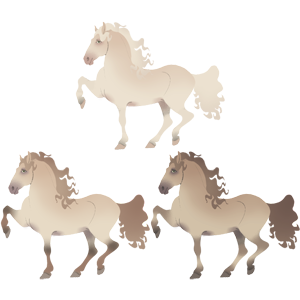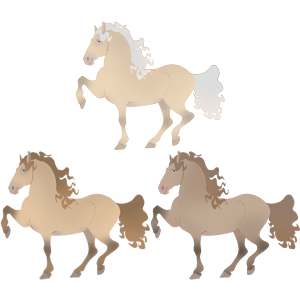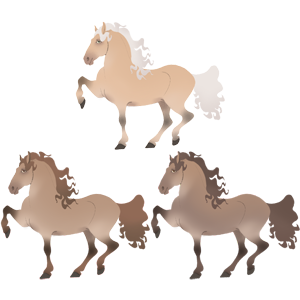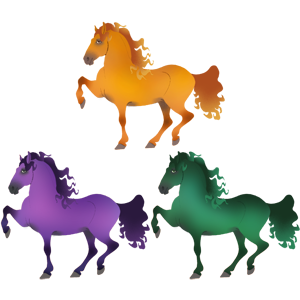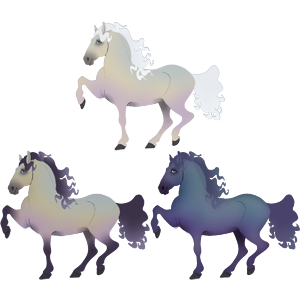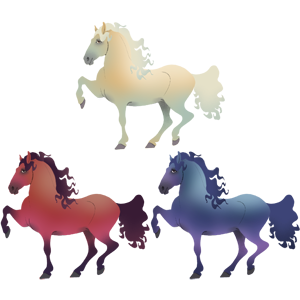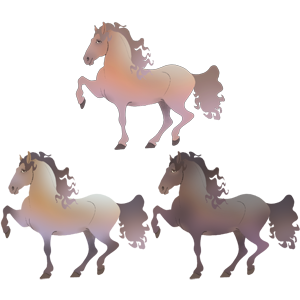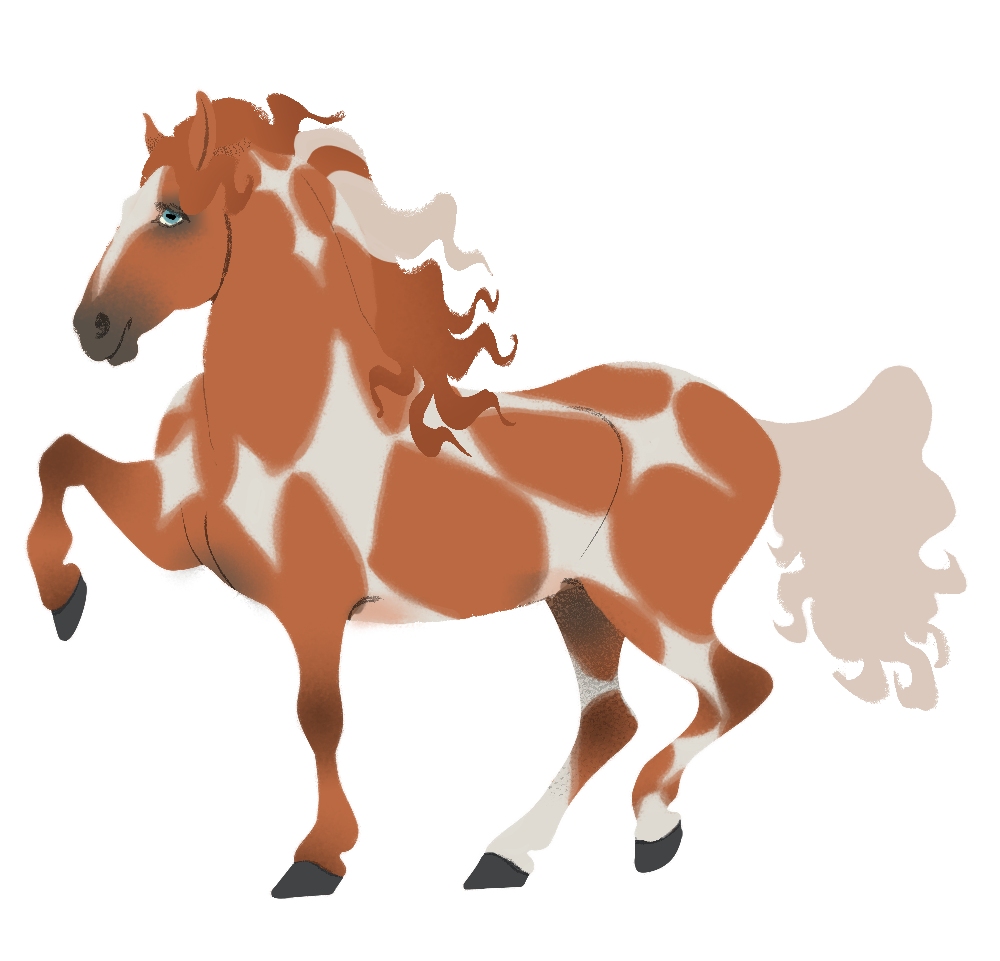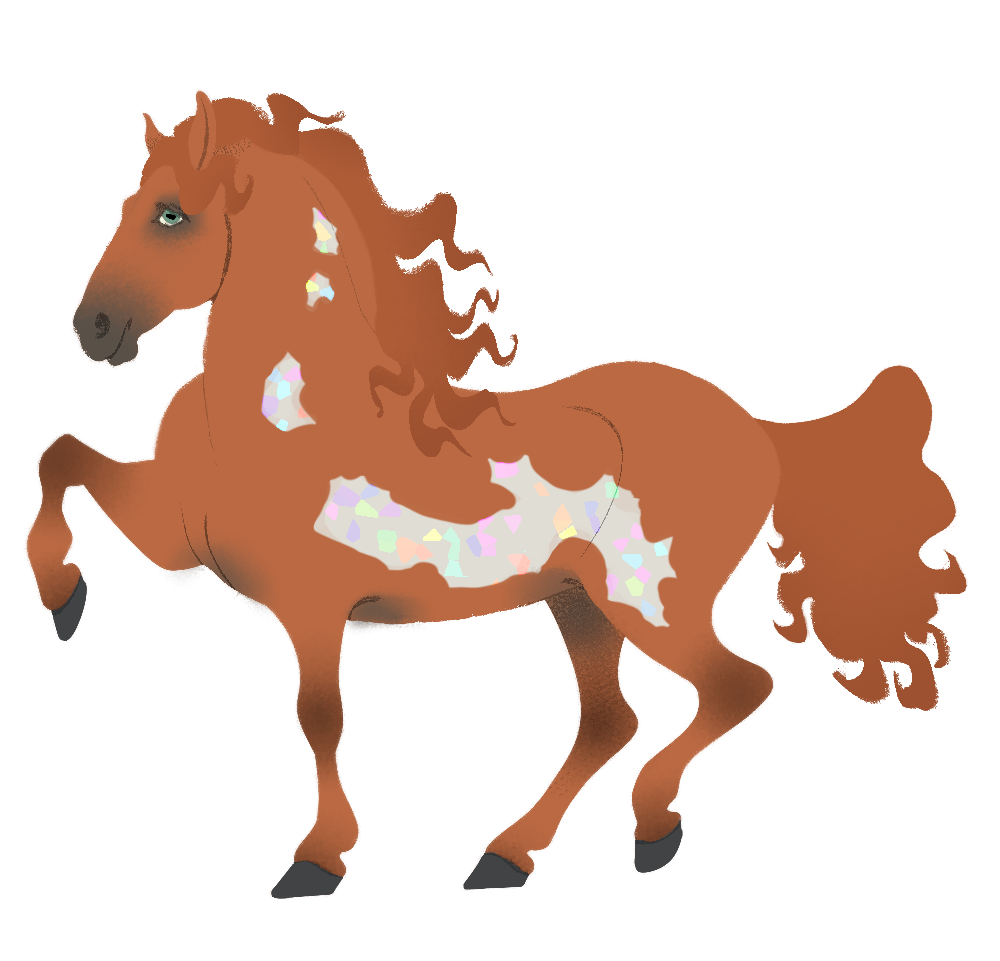Traits
Cream Champagne (Epic)
Gold Cream Champagne, Amber Cream Champagne, Classic Cream Champagne
Genotype: CrCr ChCh, nCr ChCh, CrCr nCh, nCr nCh, nCr Cher, CrCr Cher
When a Cream Champagne horse has homozygous Cream (CrCr),
colors may present paler than the below examples.
Gold Cream Champagne
Genotype: ee/__/Cr_/Ch_ (Cream Champagne on Chestnut)
- Coat Color: Pale cream, similar to Cremello. Relatively even in tone across the body.
- Mane and Tail Color: White or pale cream. Darker roots are acceptable.
- Skin Color: Light gray or pink; may have gray freckles.
- Eye Color: Blue or green.
- Hoof Color: Solid cream or brown.

Amber Cream Champagne
Genotype: E_/A_/Cr_/Ch_ (Cream Champagne on Bay)
- Coat Color: Pale cream, not white but very light. Warm brown stockings up to the knees or hocks (or higher), blended into the body color.
- Mane and Tail Color: Warm brown. May be darker at the roots or faded to a lighter color at the tips.
- Skin Color: Light gray or pink; may have gray freckles.
- Eye Color: Blue or green.
- Hoof Color: Solid cream or brown.

Classic Cream Champagne
Genotype: E_/aa/Cr_/Ch_ (Cream Champagne on Black)
- Coat Color: Pale creamy brown, which may have a peachy or lavender undertone. Relatively even in tone across the body.
- Mane and Tail Color: Slightly darker than the body. May be darker at the roots or faded to a lighter color at the tips.
- Skin Color: Light gray or pink; may have gray freckles.
- Eye Color: Blue or green.
- Hoof Color: Solid cream or brown.

Cream Pearl (Epic)
Palomino Pearl, Buckskin Pearl, Smoky Black Pearl
Genotype: Crprl
Locus: Cream and Pearl share a locus.
Crprl horses must get the Cr gene from one parent and the prl gene from the other.
Palomino Pearl
Genotype: ee/__/Crprl (Cream Pearl on Chestnut)
- Coat Color: Shiny pale cream, similar to Cremello, but slightly darker. Relatively even in tone across the body.
- Mane and Tail Color: White or pale cream. Darker roots are acceptable.
- Skin Color: Pink.
- Eye Color: Blue or green.
- Hoof Color: Solid cream.

Buckskin Pearl
Genotype: E_/A_/Crprl (Cream Pearl on Bay)
- Coat Color: Creamy pale caramel body. Noticeable dark stockings up to the knees or hocks (or higher), blended into the body color.
- Mane and Tail Color: Warm brown, noticeably darker than the body and similar in color to the legs.
- Skin Color: Pink.
- Eye Color: Blue or green.
- Hoof Color: Solid cream.

Smoky Black Pearl
Genotype: E_/aa/Crprl (Cream Pearl on Black)
- Coat Color: Creamy brown body, with a caramel undertone. Relatively even in tone across the body.
- Mane and Tail Color: Slightly darker than the body. May be darker at the roots or faded to a lighter color at the tips.
- Skin Color: Pink.
- Eye Color: Blue or green.
- Hoof Color: Solid cream.

Pearl Champagne (Epic)
Gold Pearl Champagne, Bay Pearl Champagne, Black Pearl Champagne
Genotype: prlprl ChCh or prlprl nCh
Gold Pearl Champagne
Genotype: ee/__/prlprl/Ch_ (Pearl Champagne on Chestnut)
- Coat Color: Shiny golden cream, similar to its Cream Champagne counterpart but slightly darker. Relatively even in tone across the body.
- Mane and Tail Color: White or pale cream.
- Skin Color: Light gray or purple-pink; may have gray freckles.
- Eye Color: Gold or Green.
- Hoof Color: Solid gray or brown.

Bay Pearl Champagne
Genotype: E_/A_/prlprl/Ch_ (Pearl Champagne on Bay)
- Coat Color: Pale creamy brown, similar to its Cream Champagne counterpart but slightly darker. Warm brown stockings up to the knees or hocks (or higher), blended into the body color.
- Mane and Tail Color: Warm brown. May be darker at the roots or faded to a lighter color at the tips.
- Skin Color: Light gray or purple-pink; may have gray freckles.
- Eye Color: Gold or Green.
- Hoof Color: Solid gray or brown.

Black Pearl Champagne
Genotype: E_/aa/prlprl/Ch_ (Pearl Champagne on Black)
- Coat Color: Warm grayish brown, similar to its Cream Champagne counterpart but slightly darker. Relatively even in tone across the body.
- Mane and Tail Color: Slightly darker than the body. May be darker at the roots or faded to a lighter color at the tips.
- Skin Color: Light gray or purple-pink; may have gray freckles.
- Eye Color: Gold or Green.
- Hoof Color: Solid gray or brown.

Tapestry Champagne (Epic)
Weld Champagne, Madder Champagne, Woad Champagne
Genotype: TpTp ChCh, nTp ChCh, TpTp nCh, nTp nCh, TpTp Cher, nTp Cher
Weld Champagne
Genotype: ee/__/Tp_/Ch_ (Tapestry Champagne on Chestnut)
- Coat Color: Subdued light yellow body. May appear slightly chartreuse or peach-colored, but should not look brown or gray. Should be relatively even in tone across the body, but may get slightly darker along the topline.
- Mane and Tail Color: Pale cream or white. Darker roots are acceptable, but mane and tail should be noticeably lighter than the coat.
- Skin Color: Light gray or purple-pink; may have gray freckles.
- Eye Color: Light brown, golden, or green.
- Hoof Color: Solid brown.
Acceptable Weld Champagne Color Examples:

Madder Champagne
Genotype: E_/A_/Tp_/Ch_ (Tapestry Champagne on Bay)
- Coat Color: Subdued light red or pink body. May appear slightly magenta or slightly orange, but should not appear pastel or brown. May get slightly darker along the topline. Darker, more saturated stockings that reach the knees/hocks (or higher) and blend into the coat color.
- Mane and Tail Color: Dark red, similar in color to the legs. Darker roots are acceptable.
- Skin Color: Light gray or purple-pink; may have gray freckles.
- Eye Color: Light brown or golden.
- Hoof Color: Solid gray or black.
Acceptable Madder Champagne Color Examples:

Woad Champagne
Genotype: E_/aa/Tp_/Ch_ (Tapestry Champagne on Black)
- Coat Color: Subdued medium-blue body. May appear slightly indigo or turquoise, but should not appear pastel or gray. Should be relatively even in tone across the body, but may get darker along the topline.
- Mane and Tail Color: The same color as the body or slightly darker.
- Skin Color: Light gray or purple-pink; may have gray freckles.
- Eye Color: Brown, gray, or green.
- Hoof Color: Solid gray or black.
Acceptable Woad Champagne Color Examples:

Tapestry Pearl (Epic)
Ochre Pearl, Tyrian Pearl, Phthalo Pearl
Genotype: Tpprl
Tapestry and Pearl share a locus.
Tpprl horses must get the Tp gene from one parent and the prl gene from the other.
Ochre Pearl
Genotype: ee/__/Tpprl (Tapestry Pearl on Chestnut)
- Coat Color: Vivid, almost iridescent orange, mostly even in tone across the entire body. Should be robust in both saturation in value, and clearly a secondary color; the coat should not appear too yellow nor too red.
- Mane and Tail Color: Same color as the coat. Slightly lighter or darker than the coat is acceptable.
- Skin Color: Brown or pink-brown.
- Eye Color: Orange, golden, or brown.
- Hoof Color: Solid brown.
Acceptable Ochre Pearl Color Examples:

Tyrian Pearl
Genotype: E_/A_/Tpprl (Tapestry Pearl on Bay)
- Coat Color: Vivid, almost iridescent violet, mostly even in tone across the entire body. Should be robust in both saturation in value, and clearly a secondary color; the coat should not appear too blue nor too red. Noticeable dark stockings up to the knees or hocks (or higher), blended into the body color.
- Mane and Tail Color: Visibly darker than the body and similar in color to the legs.
- Skin Color: Gray or brown.
- Eye Color: Gray or brown.
- Hoof Color: Solid gray.
Acceptable Tyrian Pearl Color Examples:

Phthalo Pearl
Genotype: E_/aa/Tpprl (Tapestry Pearl on Black)
- Coat Color: Vivid, almost iridescent green, mostly even in tone across the entire body. Should be robust in both saturation in value, and clearly a secondary color; the coat should not appear too yellow nor too blue.
- Mane and Tail Color: Same color as the coat. Slightly lighter or darker than the coat is acceptable.
- Skin Color: Gray.
- Eye Color: Green, gray, or brown.
- Hoof Color: Solid gray.
Acceptable Phthalo Pearl Color Examples:

Cream Ether (Epic)
Cold Cream Ether, Ombre Cream Ether, Classic Cream Ether
Genotype: CrCr erer, nCr erer
When a Cream Ether horse has homozygous Cream (CrCr),
colors may present paler than the below examples.
Cold Cream Ether
Genotype: ee/__/Cr_/erer (Cream ether on Chestnut)
- Coat Color: Pale cream, with silver-blue hues at the topline and pale purple-pink under the barrel, on the face, and on the top half of the legs. Color shift should be gradual and be relatively even in value across the body.
- Mane and Tail Color: White or bluish-silver. Darker roots are acceptable.
- Skin Color: Gray.
- Eye Color: Pale gray or brown.
- Hoof Color: Solid gray.

Ombre Cream Ether
Genotype: E_/A_/Cr_/erer (Cream ether on Bay)
- Coat Color: Pale cream, with silver-blue hues at the topline and pale purple-pink under the barrel, on the face, and on the top half of the legs. Color shift should be gradual and be relatively even in value across the barrel. Legs should have dark purple-black stockings to the knee and hock (or higher) which blend into the body color.
- Mane and Tail Color: Purple-black. May be darker at the roots or faded to a lighter color at the tips.
- Skin Color: Gray.
- Eye Color: Gray or brown.
- Hoof Color: Solid gray.

Classic Cream Ether
Genotype: E_/aa/Cr_/erer (Cream ether on Black)
- Coat Color: Subdued blue-purple, with blue along the topline and the purple hues exaggerated on the face and on the top half of the legs. Color shift should be gradual and be relatively even in value across the body.
- Mane and Tail Color: Slightly darker than the body. May be darker at the roots or faded to a lighter color at the tips.
- Skin Color: Gray.
- Eye Color: Gray or brown.
- Hoof Color: Solid gray.

Tapestry Ether (Epic)
Weld Ether, Madder Ether, Woad Ether
Genotype: TpTp erer, nTp erer
Weld Ether
Genotype: ee/__/Tp_/erer (Tapestry ether on Chestnut)
- Coat Color: Similar base coat to Tapestry Cream, with silver at the topline and pale blue under the barrel, on the face, and on the top half of the legs. Color shift should be gradual and be relatively even in value across the body. Base coat should be obviously yellow and not appear too tan, green, or orange.
- Mane and Tail Color: White or blue-silver. Darker roots are acceptable.
- Skin Color: Gray.
- Eye Color: Pale gray or brown.
- Hoof Color: Solid gray.

Madder Ether
Genotype: E_/A_/Tp_/erer (Tapestry ether on Bay)
- Coat Color: Similar base coat to Tapestry Cream, with silvery desaturation at the topline and vibrant pink under the barrel, on the face, and on the top half of the legs. Color shift should be gradual and be relatively even in value across the barrel. Legs should have dark purple-black stockings to the knee and hock (or higher) which blend into the body color.
- Mane and Tail Color: Purple-black. May be darker at the roots or faded to a lighter color at the tips.
- Skin Color: Gray or black.
- Eye Color: Gray or brown.
- Hoof Color: Solid gray or black.

Woad Ether
Genotype: E_/aa/Tp_/erer (Tapestry ether on Black)
- Coat Color: Similar base coat to Tapestry Cream, with silver along the topline and robust purple hues under the barrel, on the face, and on the top half of the legs. Color shift should be gradual and be relatively even in value across the body.
- Mane and Tail Color: Slightly darker than the body. May be darker at the roots or faded to a lighter color at the tips.
- Skin Color: Gray or black.
- Eye Color: Gray or black.
- Hoof Color: Solid gray or black.

Pearl Ether (Epic)
Gold Pearl Ether, Bay Pearl Ether, Black Pearl Ether
Genotype: prlprl erer
Gold Pearl Ether
Genotype: ee/__/prlprl/erer (Pearl ether on Chestnut)
- Coat Color: Shiny warm caramel brown, with silver hues at the topline and warm pink under the barrel, on the face, and on the top half of the legs. Color shift should be gradual and be relatively even in value across the body.
- Mane and Tail Color: Warm caramel brown, may be slightly darker or lighter than the body.
- Skin Color: Pink or gray-pink
- Eye Color: Pale gray or pale brown.
- Hoof Color: Solid gray or brown.

Bay Pearl Ether
Genotype: E_/A_prlprl/erer (Pearl ether on Bay)
- Coat Color: Shiny warm caramel brown, with silver hues at the topline and warm pink under the barrel, on the face, and on the top half of the legs. Color shift should be gradual and be relatively even in value across the barrel. Noticeable dark stockings up to the knees or hocks (or higher), blended into the body color.
- Mane and Tail Color: Dark brown, noticeably darker than the body and similar in color to the legs.
- Skin Color: Pink or gray-pink
- Eye Color: Pale gray or pale brown.
- Hoof Color: Solid gray or brown.

Black Pearl Ether
Genotype: E_/aa/prlprl/erer (Pearl ether on Black)
- Coat Color: Shiny grayish brown, with a warm caramel undertone. Silver hues visible at the topline and warm pink under the barrel, on the face, and on the top half of the legs Color shift should be gradual and be relatively even in value across the body.
- Mane and Tail Color: Slightly darker than the body. May be darker at the roots or faded to a lighter color at the tips.
- Skin Color: Pink or gray-pink
- Eye Color: Pale gray or pale brown.
- Hoof Color: Solid gray or brown.

Harlequin (Epic)



Harlequin is a white marking that presents as a series of vaguely diamond-shaped markings connected at the corners.
Harlequin tends to "radiate out" from a single place, with rings of connected diamonds all pointing towards one point, usually the poll or the croup.
Diamond markings vary in size but must be no smaller than the horse's eye and no larger than the horse's head.
Diamonds may be disconnected from the rest of the Harlequin pattern as long as they are oriented in the same direction as the rest of the marking.
Most diamonds should be connected, however "breaks" or gaps in rings of diamonds are acceptable.
Harlequin markings will never have jagged edges, holes, or spots.
Genotype: Hq_
Locus: Not shared with any known genes
- Coat: Harlequin is a white marking.
- Mane and Tail: White where touching marking.
- Skin: Pink under marking.
- Eyes: Can cause blue eyes.
- Hooves: Not affected.
Range:
- Minimum: Two white diamond-shaped markings connected at the corners. The diamonds must be somewhere on the barrel or neck, and must be at least the size of the horse's eye.
- Maximum: A pattern of diamonds that covers the entire neck, head, barrel, and hindquarters. Up to two legs (either both forelegs or both hind legs) may have diamond markings.
Interactions:
- Chimera & Somatic: Chimera and Somatic markings have an unusual tendency to "fill" the spaces between Harlequin diamonds. Additionally, horses with both Harlequin and the Chimera anomaly can sometimes display two different colors of Chimera markings.
Fewspot (Epic)



Fewspot is a white marking that covers the body, with the base coat barely showing through at all.
Only a small number of spots are possible, and should be mostly located on the hocks/knees, fetlocks, groin and elbow areas.
Color around the muzzle and eyes is possible. Spots should never be larger than the horse's eye.
Genotype: LpLp patnpatn
Locus: Fewspot is part of the Leopard Complex group of patterns, along with Snowflake, Snowcap, Blanket, Leopard, and Varnish Roan.
- Coat: Fewspot is a white marking.
- Mane and Tail: White except where touching spots. May create a gradient effect.
- Skin: May cause pink speckled skin.
- Eyes: Not affected.
- Hooves: May cause tan-striped hooves.
Range:
- Minimum: A white body with only a few small freckles of visible base color near the elbows or groin.
- Maximum: A white body with speckled color visible on the knees, hocks, groin and elbow areas, and near the eyes and muzzle, with a small number of freckles visible on the body.
Opal (Epic)
 Opal on Chestnut Tobiano
Opal on Chestnut Tobiano Opal on Chestnut Overo
Opal on Chestnut Overo Opal on Dominant White Chestnut
Opal on Dominant White Chestnut
Opal causes colorful pastel flecks on white markings.
Opal will always cause randomly-placed colorful flecks of no fewer than 3 different colors.
Flecks should be no larger than the horse's eye, and should cover no more than half the surface of white markings.
If mane/tail are affected by a white marking, Opal may color strands it touches.
Genotype: Op_
Locus: Not shared with any known genes
- Coat: Pale colorful flecks on all white markings, including Free White.
- Mane and Tail: Where affected by white markings, can be colored to match touching flecks.
- Skin: Not affected.
- Eyes: Not affected.
- Hooves: Not affected.
Range:
- Minimum: Subtle multicolor-tinted shapes on white markings.
- Maximum: Bold multicolor flecks on white markings that are slightly tinted to match.
Interactions:
- Roan: Opal is optionally invisible on Roan. If you choose to show Opal on Roan, the colorful flecks must be the same as other present white markings, but with lower opacity to match Roan.
- False Leopard: Opal is optionally invisible on False Leopard. If you choose to show Opal on False Leopard, the colorful flecks must be the same as other present white markings, but with lower opacity to match False Leopard.

Color-tinted Opal on Gilt Tyrian Pearl Champagne Splash

Opal on Blanched Classic Cream Ether
Heterozygous Filigree (Epic)
This trait is attached to horses that Carry Filigree.
Filigree is a white marking that appears as elegant swirls that branch out of other white markings, including free white.
Filigree is recessive; a horse needs to be homozygous with two copies of the gene (fefe) for it to be visible.
A carrier with only one copy of the gene (nfe) will not express Filigree.
Genotype: nfe
Locus: Not shared with any known genes
Horses with 'nfe' will be noted as 'Carrying Filigree' but will not show the gene.
Expression of heterozygous (carried) Filigree:
- Coat: Not affected.
- Mane and Tail: Not affected.
- Skin: Not affected.
- Eyes: Not affected.
- Hooves: Not affected.

